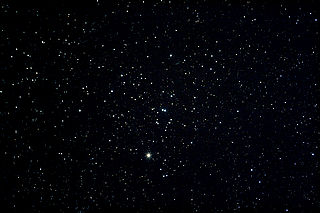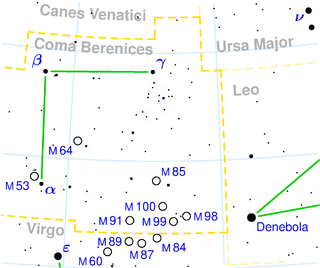
Proper motion is the astrometric measure of the observed changes in the apparent places of stars or other celestial objects in the sky, as seen from the center of mass of the Solar System, compared to the abstract background of the more distant stars.

The Pleiades, also known as the Seven Sisters, Messier 45, and other names by different cultures, is an asterism and an open star cluster containing middle-aged, hot B-type stars in the north-west of the constellation Taurus. At a distance of about 444 light years, it is among the nearest star clusters to Earth. It is the nearest Messier object to Earth, and is the most obvious cluster to the naked eye in the night sky. It is also observed to house the reflection nebula NGC 1432, an HII region.

The Hyades is the nearest open cluster and one of the best-studied star clusters. Located about 153 light-years away from the Sun, it consists of a roughly spherical group of hundreds of stars sharing the same age, place of origin, chemical characteristics, and motion through space. From the perspective of observers on Earth, the Hyades Cluster appears in the constellation Taurus, where its brightest stars form a "V" shape along with the still-brighter Aldebaran. However, Aldebaran is unrelated to the Hyades, as it is located much closer to Earth and merely happens to lie along the same line of sight.

Coma Berenices is an ancient asterism in the northern sky, which has been defined as one of the 88 modern constellations. It is in the direction of the fourth galactic quadrant, between Leo and Boötes, and it is visible in both hemispheres. Its name means "Berenice's Hair" in Latin and refers to Queen Berenice II of Egypt, who sacrificed her long hair as a votive offering. It was introduced to Western astronomy during the third century BC by Conon of Samos and was further corroborated as a constellation by Gerardus Mercator and Tycho Brahe. It is the only modern constellation named for a historic person.

Hipparcos was a scientific satellite of the European Space Agency (ESA), launched in 1989 and operated until 1993. It was the first space experiment devoted to precision astrometry, the accurate measurement of the positions of celestial objects on the sky. This permitted the first high-precision measurements of the intrinsic brightnesses, proper motions, and parallaxes of stars, enabling better calculations of their distance and tangential velocity. When combined with radial velocity measurements from spectroscopy, astrophysicists were able to finally measure all six quantities needed to determine the motion of stars. The resulting Hipparcos Catalogue, a high-precision catalogue of more than 118,200 stars, was published in 1997. The lower-precision Tycho Catalogue of more than a million stars was published at the same time, while the enhanced Tycho-2 Catalogue of 2.5 million stars was published in 2000. Hipparcos' follow-up mission, Gaia, was launched in 2013.

The Beehive Cluster, is an open cluster in the constellation Cancer. One of the nearest open clusters to Earth, it contains a larger population of stars than other nearby bright open clusters holding around 1,000 stars. Under dark skies, the Beehive Cluster looks like a small nebulous object to the naked eye, and has been known since ancient times. Classical astronomer Ptolemy described it as a "nebulous mass in the breast of Cancer". It was among the first objects that Galileo studied with his telescope.

Beta Comae Berenices is a main sequence dwarf star in the northern constellation of Coma Berenices. It is located at a distance of about 29.95 light-years from Earth. The Greek letter beta (β) usually indicates that the star has the second highest visual magnitude in the constellation. However, with an apparent visual magnitude of 4.3, this star is actually slightly brighter than α Comae Berenices. It can be seen with the naked eye, but may be too dim to be viewed from a built-up urban area.
47 Arietis is a single star in the northern constellation of Aries. The designation is from the star catalogue of English astronomer John Flamsteed, first published in 1712. It is faintly visible to the naked eye with an apparent visual magnitude of 5.80. It has an annual parallax shift of 30.15 ± 0.30 mas, which is equivalent to a physical distance of approximately 108 light-years from Earth.

4 Cassiopeiae is a red giant in the northern constellation of Cassiopeia, located approximately 790 light-years away from the Sun. It is visible to the naked eye as a faint, red-hued star with a baseline apparent visual magnitude of 4.96. At the distance of this system, its visual magnitude is diminished by an extinction of 0.56 due to interstellar dust. This system is moving closer to the Earth with a heliocentric radial velocity of −39 km/s.

The Alpha Persei Cluster, also known as Melotte 20 or Collinder 39, is an open cluster of stars in the northern constellation of Perseus. To the naked eye, the cluster consists of several blue-hued spectral type B stars. The most luminous member is the ~2nd magnitude white-yellow supergiant Mirfak, also known as Alpha Persei. Bright members also include Delta, Sigma, Psi, 29, 30, 34, and 48 Persei. The Hipparcos satellite and infrared color-magnitude diagram fitting have been used to establish a distance to the cluster of ~560 light-years (172 pc). The distance established via the independent analyses agree, thereby making the cluster an important rung on the cosmic distance ladder. As seen from the Earth, the extinction of the cluster due to interstellar dust is around 0.30.
Gamma Comae Berenices, Latinized from γ Comae Berenices, is a single, orange-hued star in the northern constellation of Coma Berenices. It is faintly visible to the naked eye, having an apparent visual magnitude of 4.36. Based upon an annual parallax shift of 19.50 mas as seen from Earth, its distance can be estimated as around 167 light years from the Sun. The star is moving away from the Sun with a radial velocity of +3 km/s.

Chi Ceti , is the Bayer designation for a double star in the equatorial constellation of Cetus. They appear to be common proper motion companions, sharing a similar motion through space. The brighter component, HD 11171, is visible to the naked eye with an apparent visual magnitude of 4.66, while the fainter companion, HD 11131, is magnitude 6.75. Both lie at roughly the same distance, with the brighter component lying at an estimated distance of 75.6 light years from the Sun based upon an annual parallax shift of 43.13 mass.
23 Comae Berenices is a binary star system in the northern constellation of Coma Berenices, situated a few degrees away from the North Galactic Pole. It is visible to the naked eye as a faint, white-hued point of light with an apparent visual magnitude of 4.80. The system is located around 310 light years away from the Sun, based on parallax. It is moving closer to the Earth with a heliocentric radial velocity of −16 km/s.
16 Comae Berenices is a single star in the northern constellation of Coma Berenices. 16 Comae Berenices is the Flamsteed designation. It is a member of the Coma Star Cluster and is visible to the naked eye with an apparent visual magnitude of 4.96. Based upon an annual parallax shift of 11.7 mas, it is located about 279 light years away.

28 Monocerotis is a single star in the equatorial constellation of Monoceros. It has an orange-hue and is faintly visible to the naked eye with an apparent visual magnitude of 4.69. The distance to this star is approximately 450 light years based on parallax, and it has an absolute magnitude of −1.00. The star is drifting further away from the Sun with a radial velocity of +26.7 km/s.
13 Comae Berenices is a probable binary star system in the northern constellation of Coma Berenices. It has an apparent visual magnitude of 5.17, which is bright enough to be faintly visible to the naked eye. With an annual parallax shift of 12.33 mas, it is located around 260 light years from the Sun. It is member of the nearby Coma Star Cluster.
Iota2 Fornacis is the Bayer designation for a star in the southern constellation of Fornax. It is faintly visible to the naked eye on a dark night, having an apparent visual magnitude of 5.83. The distance to this star, based upon an annual parallax shift of 29.46 mas, is around 111 light-years. It is a member of the thin disk population of the Milky Way galaxy.

21 Comae Berenices is a variable star in the northern constellation of Coma Berenices. It has the variable star designation UU Comae Berenices, while 21 Comae Berenices is the Flamsteed designation.

17 Comae Berenices is a multiple star system in the northern constellation of Coma Berenices. The brighter component, 17 Com A, is a naked eye star with an apparent visual magnitude of 5.2. It has a faint companion of magnitude 6.6, 17 Com B, positioned at an angular separation of 146.4″ along a position angle of 251°, as of 2018. They are located at a distance of approximately 240 light years from the Sun based on parallax measurements.













